
Employee expense reimbursement is a standard process for almost every company. To ensure an agile and efficient process, avoiding incorrect refunds, financial miscalculations, and loss of money, Finance teams must create a solid workflow to manage and pay reimbursement requests.
It’s likely that when you think about the reimbursement process, you think of piles of invoices, paperwork, tight deadlines, and repetitive tasks with constant touchpoints among many people. Well, there is a much easier and smarter way to manage it: with a digitized and automated process in Pipefy.
Reimbursements: Why complicate it?
Companies need to have tight financial control to maintain accurate records, avoiding fraud and waste — but it shouldn’t be a headache.
Corporate expense reimbursements cover different expenses such as travel, lunch with clients, lodging, transportation, and many others. Because there are so many variations in this process, we highly recommended having a well-advertised and clear refund policy with a standardized workflow.
This is essential to create a positive and transparent experience for all employees when opening requests, as this process can harm the relationship between employees and the company if it is poorly managed.
Managing corporate expenses and controlling requests is not extremely complex, but it can become a major challenge if it isn’t done properly. When badly supervised, it becomes a snowball, resulting in financial losses due to poor execution and longer deadlines.
Among the main challenges of Finance teams, here are some common ones:
- Communication. Bad communication with requesters and teams can result in scattered information, poor collaboration, and missed deadlines.
- Repetitive work. Time spent on manual tasks like sending emails, updating spreadsheets, and requesting approvals could easily be automated.
- Lack of visibility. Without clarity of requests, urgency, and the status of each demand in the backlog, it is easy to get lost in the midst of deadlines and generate delays.
- Lack of standardization. Refund requests can come via emails, phone calls, Slack, or Teams messages, which results in decentralized information.
- Approvals bottlenecks. Requesting approvals from other teams can be time-consuming and a true bottleneck, especially if people aren’t notified promptly.
Instead of having information scattered across emails, spreadsheets, papers, and multiple systems, you can centralize your entire reimbursement operation and orchestrate it from a single place. By using a dedicated system like Pipefy, you will eliminate the biggest hassles of the workflow and reach a higher level of process maturity.
Check out the main benefits that Finance teams get with Pipefy:
- Automations to speed up your process (such as type of approval according to the refund amount) and streamline your workflow to mitigate human errors.
- Integrations to connect with different systems and ERPs to ensure your operation takes place in Pipefy while other platforms are updated.
- Customizations to create a process that meets your company’s reimbursement policies with customizable fields adaptable to your needs.
- Automated approval flows to notify and trigger approvers according to your rules.
- Control and visibility to find all requests at a glance, identify urgent ones, and keep requesters up to date.
To save money, foster a good relationship with employees, and create a reliable operation, you need to follow a few steps. In this article, we’ve put together an expense reimbursement request tutorial in Pipefy so you can put the best version of this process into practice.
The ultimate tutorial for a refund request process
In the Pipefy Template Gallery, you will find a template for the expense reimbursement process that works as a starting point for further customizations. The following flowchart represents part of this basic template, with some additions:

Keep in mind this is the beginning (and a simple version) of how an employee expense reimbursement works inside Pipefy; it all depends on your company’s refund policies (what is considered refundable or not) — and you can adapt the process as you prefer. Let’s check out each of the phases and learn how to face the challenges listed!
Stage 1: Reimbursement requests
The reimbursement process begins with creating the expense request, which should be a standardized document to collect the essential information to start the process. This request, which can be made in different formats, gathers the data to properly compensate the employee according to the company’s reimbursement policies.
One of the best ways to receive reimbursement requests is through online forms. The Finance team structures the questions related to the expense, ensuring that all the key information is collected so requests arrive ready to be analyzed. Regardless of the refund type, some items need to be specified to make finance analysts’ life easier:
- Requester’s name
- Requester’s email
- Expense category
- Expense date
- Total amount
- Invoice/Voucher
- Bank information
- Payment method
After collecting all this information, the Finance team analyzes the request. Of course, depending on your company scenario, other data may be required. Remember to spread the word widely about the refund policy to prevent employees from asking for reimbursements that are not covered or after the deadline for claims.
Forms: A mistake-proof refund request
In Pipefy, refund requests are made through forms. They can be shared with collaborators through an external link, so it is not necessary to log in to Pipefy to send the expense request.
With forms, you can add as many fields as you like to collect the information needed to start the refund. It is possible to select mandatory fields so no data is left behind or conditional fields, which are displayed according to the employees’ responses.
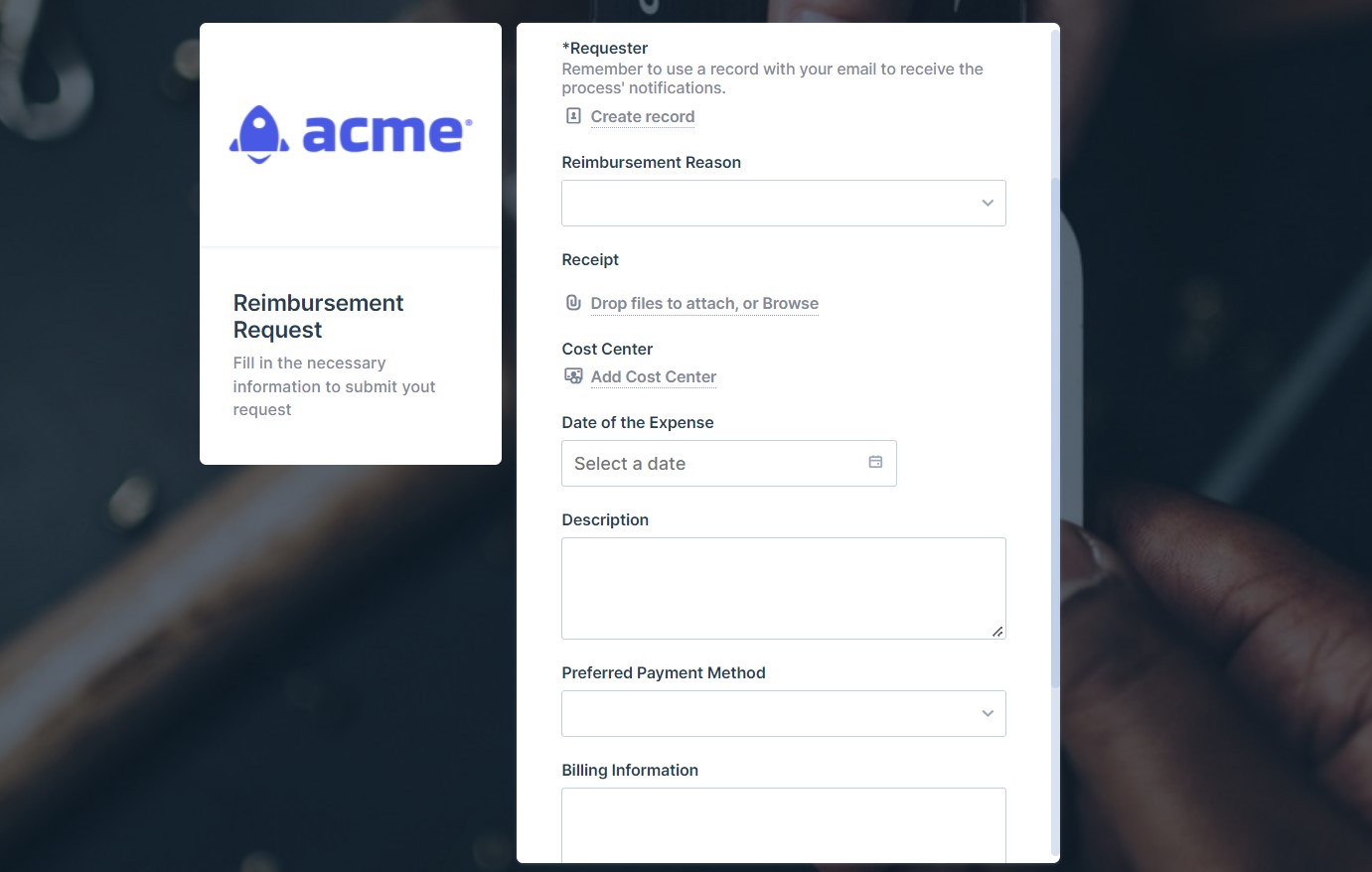
Cards: One card for each request
When submitted, forms take the shape of a card and appear inside Pipefy. Each card represents a specific refund request in your process flow, displayed on a kanban board or in list format. In a quick glance, you can see all the process phases and identify which card is in each phase.
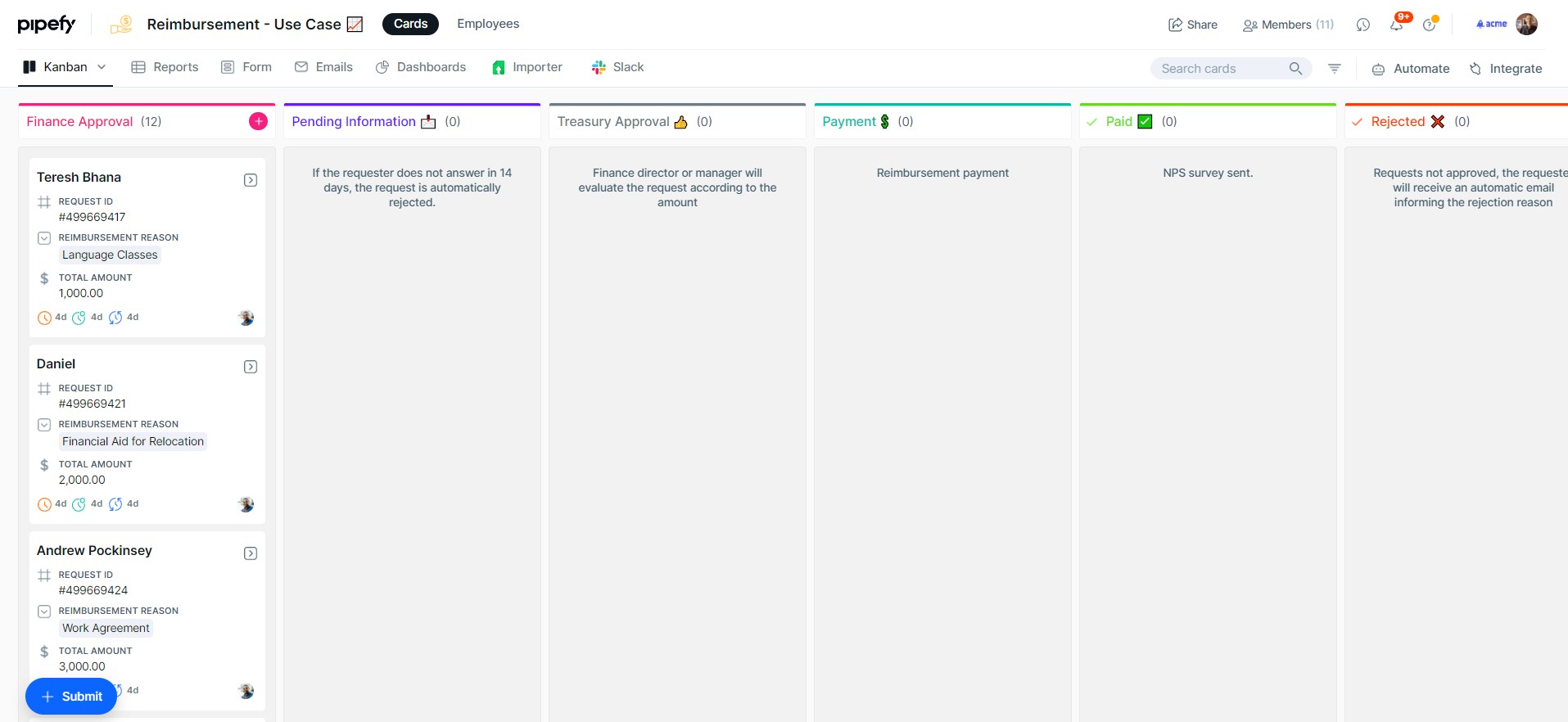
Employee database: All information at your fingertips
With our databases feature, you can create a digital library of your company’s employees within Pipefy. For example, by entering the database field in the request form, you can automatically pull all the details of an employee, such as name, department, bank information, address, etc.
Databases are customized as you wish, so you can create records for different categories. We recommend creating a database to register employees’ data, but it is also interesting to create one for cost centers divided by each department, so that information such as approvers and team budgets are easily consulted and automated throughout the whole process.

Request tracker: Keep employees aware of the status of each request
Employees are usually anxious to know if the refund will be accepted and when it will be in their account, which leads to several questions for the Finance team. With the request tracker, each employee receives a link in their email to view request status (without accessing Pipefy), with the possibility of checking what phase the demand is in and even sending additional comments.

Stage 2: Finance approval
Once the refund request is sent, it is up to the financial analyst to analyze it. It is important to define who is responsible for the analysis and what criteria must be taken into account. For example, for reimbursements smaller than $200, one analyst is assigned, while another analyst is chosen for larger amounts.
These approval levels are based on the company’s internal hierarchy and refund policies. With clear rules, you can optimize the process and save time without doing prior analysis. Simple expenses can be reviewed by only one professional, while complex costs involve multiple approvals.
Remember to request all information on the form, since the employee will be reimbursed if they meet the defined rules. These rules can be presenting the invoice or proof of payment, having an expense accepted by the company and within the budget, and submitting the request in the determined period (normally, no later than 30 days after the expense).
Automations: Automatic assignment of analysts
In Pipefy, you can create automations with customizable rules. For example, in the Finance approval phase, you can set a rule based on the total amount value, automatically assigning the best analyst to deal with the request. Another example is the possibility of moving cards based on phase fields (if there is missing data, the order goes to Pending Information).
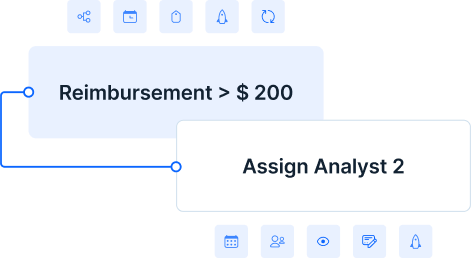
Integrations: A connected operation
Pipefy integrates with different systems and apps, sending information to third-party applications. For example, it is possible to integrate Slack or Microsoft Teams with Pipefy, so the Finance team group is always notified when a new order is submitted.
You can also connect it to the ERP of your choice (such as NetSuite) and create different rules. For example, when a request is created in the system it will directly replicate the information in the card or when a card is moved to the Payment phase in Pipefy, the payment will be issued automatically in the connected software.
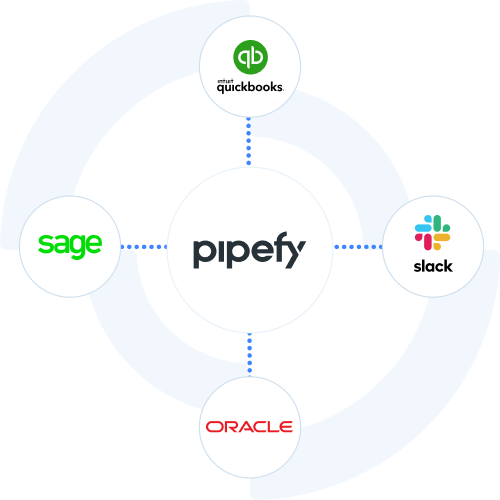
Stage 3: Pending information
Even with a form to collect the details of the reimbursement request, important data may escape or the financial analyst may need additional information to proceed with the task. In these cases, the request is paused until all information is collected or clarified with the employee.
Automated emails: Save time with dynamic messages
Pipefy allows you to send emails directly from the platform — so every message exchange is associated with the reimbursement request card, which contains the employee’s data. Emails can be sent automatically or manually, either via Pipefy’s shared mailbox or via the card.
You can even create an email template, so you don’t have to type the exact same text every time you send a message. The template contains dynamic fields, which are filled with card data. For example, whenever a card reaches the Pending information phase, an email is automatically sent to the contributor.
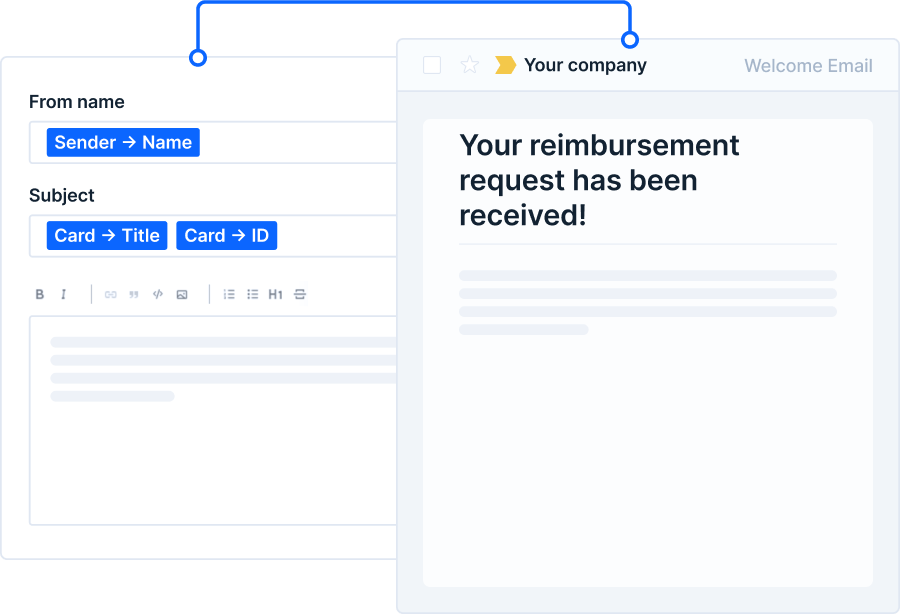
Phase forms: Receive external inputs throughout the process
It is possible to receive external information throughout the process phases — just enable a phase form and share the link. When sending an email template to the employee asking for more details, you can include a link to the phase form, so they add all the missing data. Once they send it back, you will receive the information directly in the phase in Pipefy.
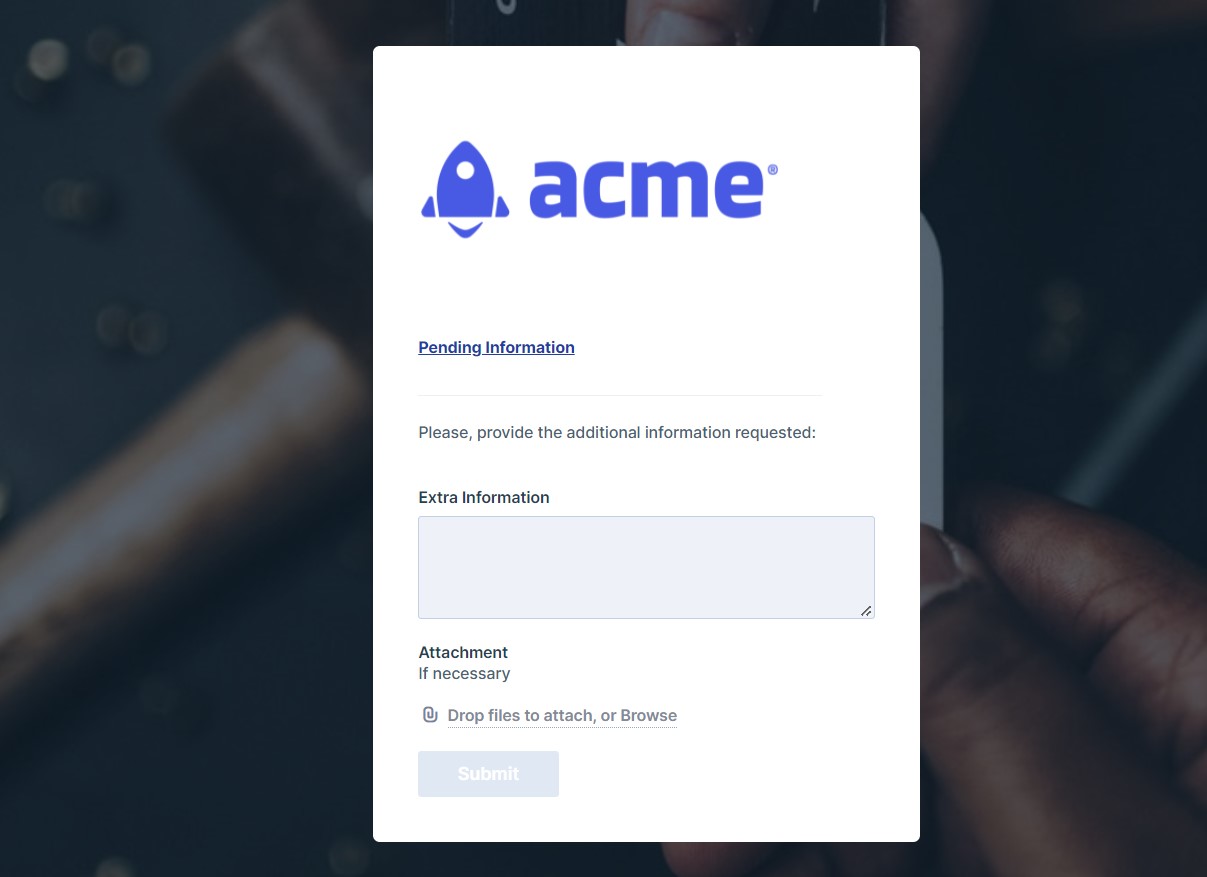
Stage 4: Treasury approval
Once everything is okay with the expense reimbursement request, it is time for treasury approval. Here, the finance analyst examines the budget availability of the cost center, and approves or not the payment, checking once more if it is within the company’s reimbursement rules.
Keep in mind that the higher the value, the more approvers can be contacted to verify the payment need, avoiding fraud and money waste. While the approval phase is essential to the process, it’s important not to make it a bottleneck. Otherwise, deadlines can be exceeded and internal friction can arise.
Normally, it is enough to pass the request through the financial analyst and the area manager. Avoid bureaucracy or unnecessary steps to optimize the whole process, so automating much of the flow and centralizing the operation in a single system is recommended. If the refund is not approved, the manager must describe the reason and inform the requester.
Visibility: Labels, filters, and alerts
Pipefy allows you to have full visibility of reimbursement requests. With labels, you can flag different types of refunds and filter them by categories like customer lunch, travel costs, and more. With comments on the cards, you ensure that those involved exchange information inside Pipefy, without generating communication noise.
Also, alerts automatically notify those involved when a deadline approaches its end date, preventing delays in approvals or payments.
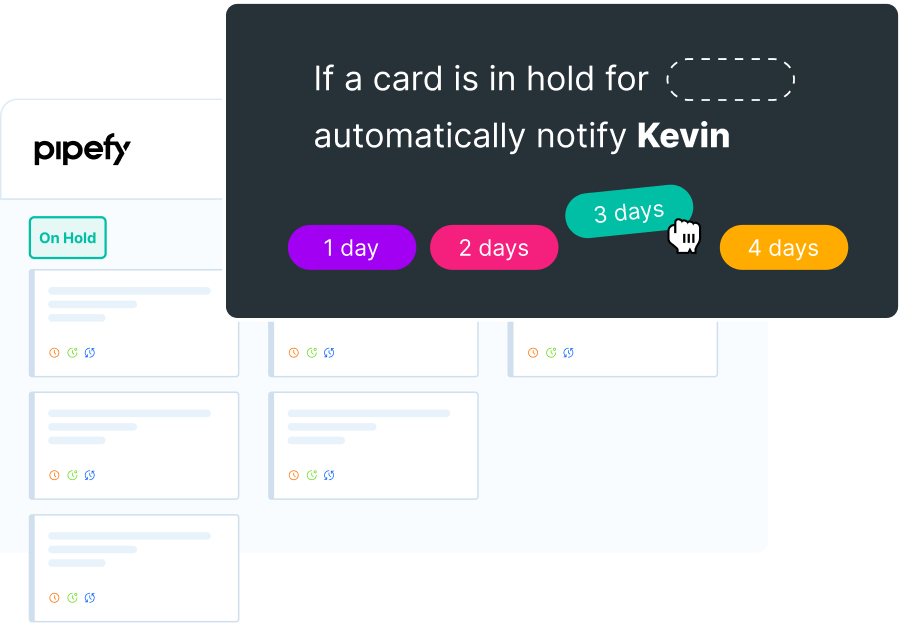
Stage 5: Payment
When all stakeholders properly approve the reimbursement, it is time to make the payment effectively. The financial analyst chooses the method (cash, credit card, bank transfer, etc.), sets the date and reimburses the employee. Invoices are stored and requests are permanently attached to employee records.
Email templates: Fast and easy communication
Again, with Pipefy’s email templates, you can set up a standard message with dynamic fields, which are populated with the card’s data. This way, when the payment is made, the employee receives an email with the compensation details. The same happens if the refund is denied, with information on the reasons for the rejection.
Another interesting use for email templates in the Payment phase is the NPS survey, so you can understand if employees are happy with the reimbursement process and find areas for improvement. Add a link to a phase form with a satisfaction survey, and responses will automatically be sent to the card.
Connections: Integrated processes and shared data
In Pipefy, you can connect several processes from the same department and share information to facilitate the team’s operation as a whole. For example, the employee database is used by both Finance and HR processes, and the cost center database can also be used for purchasing processes. In Finance, you can create and connect processes such as:
Integrations: use the ERP of your choice and connect it to Pipefy
Remember, you can connect Pipefy to whatever ERP systems you want, like NetSuite, Oracle, Sage, Quickbooks, and others. This way, the accounting tasks can happen in the other software and all the financial management inside Pipefy.
How to keep an eye on the key finance metrics
In any financial process, it is essential to have control of expenses, watch over the budget of the teams and the company, and have an accessible history of the transactions carried out. For the reimbursement process, it is valid to pay attention to metrics such as:
- Payment categories
- Average process time
- Average amount value
- Requests by department
- Total expenses by cost center
Of course, you can identify other metrics to track if they make sense for your process scenario. The key takeaway is to always measure the performance of the team’s actions, so you can find points of improvement and mitigate bottlenecks.
With Pipefy, it’s easy to visualize data with custom reports. Customization allows you to create the report with the exact information you want to extract, such as the number of requests by department or employee, values, amounts, and more. You can also import Pipefy data into a spreadsheet and share it with people outside the platform.

Dashboards make it possible to create custom charts in a few clicks. Doing so, you visualize information in charts, tables, bars, pie formats, etc. No coding knowledge is required to add or remove charts as well as to create custom reports. This guarantees autonomy in the analysis of expenses and traceable reimbursement data.
Stop wasting time and money with Pipefy
A digitalized and automated reimbursement request process is much more reliable, secure, and agile, making life easier for both employees and the Finance team. By digitizing the whole process it is easy to track information and ensure that all transactions complie with the company’s refund policies.
Not to mention that dealing with reimbursement requests from different sources (like emails, messages, phone calls, papers, etc.) is a recipe for a slow process that always requires rework. That’s why it’s so important to have a system like Pipefy that centralizes the operation and streamlines the workflow, without leaving important information behind.
With Pipefy, you implement:
- Request traceability
- Faster approval flows
- Automation of repetitive tasks
- Integrations with other systems
- Centralization of information
- Request standardization
This way, it’s easy to track departmental spending and avoid financial waste or fraud. Pipefy is the solution for Finance teams that seek a truly efficient and agile reimbursement process, fully customizable to meet their specific needs, no matter the size or field of the company.










